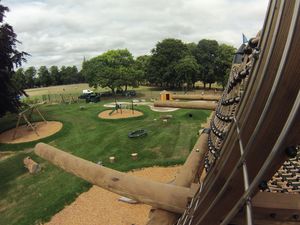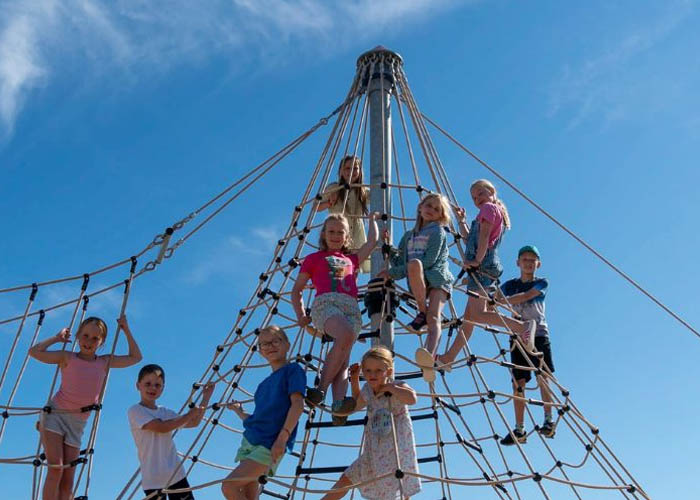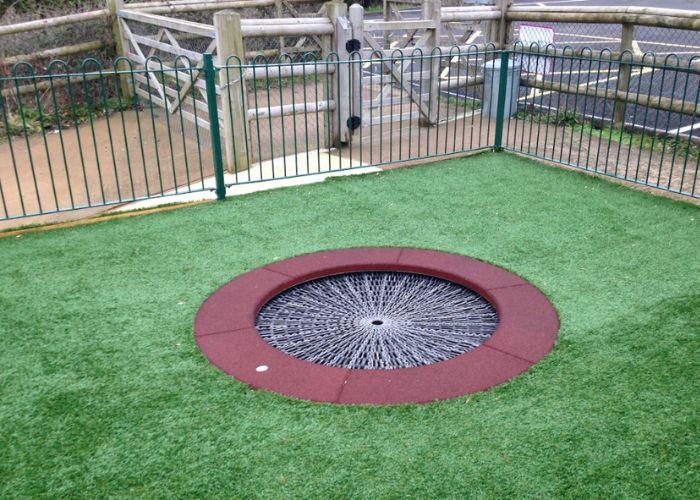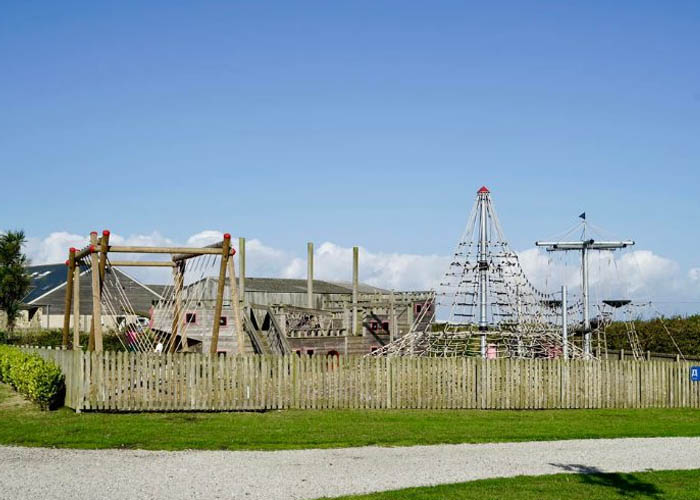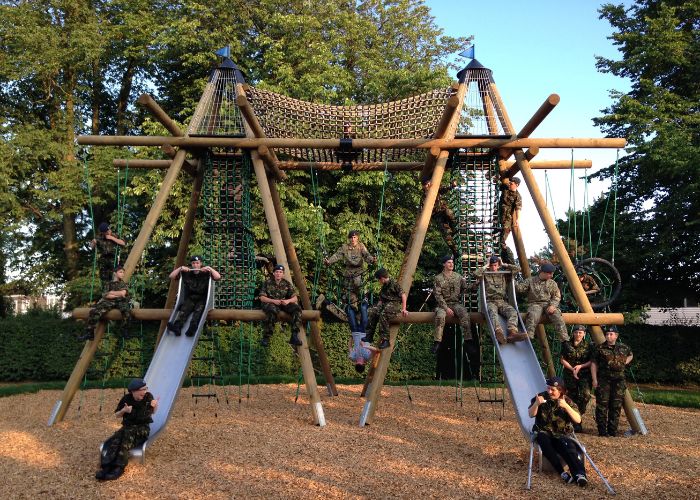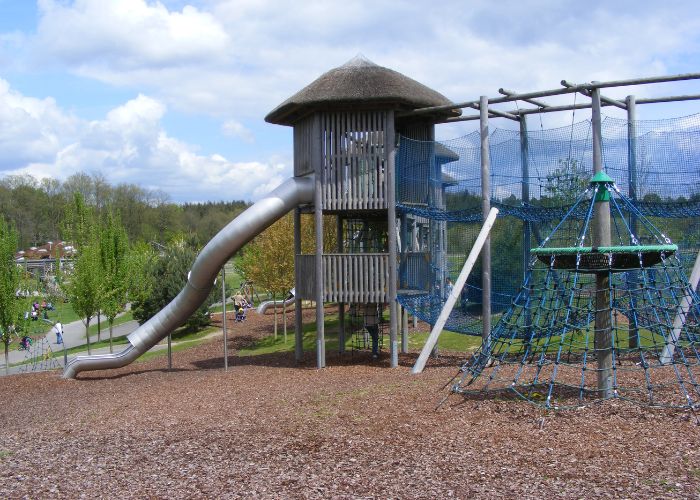How To Design A Playground That’s Popular & Inclusive
If you’re considering installing commercial playground equipment in your setting and want to know how to design a playground that’s popular, inclusive, and works within your surroundings, you’re in the right place.
|
Here at Huck Play, we've been designing playgrounds for over 20 years and have worked on projects across many industries for housing developers, attractions, holiday parks and local councils. |
We know first-hand that designing and installing a playground is an exciting and important project. It not only provides a fun and safe space for children to play but also contributes to the overall development and well-being of your community.
However, designing a playground requires knowledge, time and resources. If you’re ready to start the design phase of the playground installation process, follow our top tips on how to design a playground that meets the needs and preferences of your community.
1. Determine The Goals Of Your Playground
Determining the goals of your playground is the cornerstone of the playground design process because it sets the foundation for all subsequent decisions.
Ask yourself why you're building it—is it to foster a child's physical development, create a community hub, or provide an inclusive space for children of all abilities?
|
Understanding what your investors are looking for, be it a long-term community investment, potential for educational partnerships, or a unique landmark that stands out, will guide the budget, scale, and features of the playground. |
Prioritising key goals and ensuring that the design aligns with the intended purpose and stakeholders’ expectations while also fitting within practical constraints such as budget, space, and maintenance considerations is key.
2. Understand The Resources Available To You
When it comes to designing your playground, the resources available to you are going to define the scope of your project.
Of course, your resources stretch beyond your budget and access to land. We've broken down the most common resources required when planning your playground.
This list isn't exhaustive, and you might have other resources available in your area.
a) Your Project Timeline
Understanding your project's timeline is key when designing and building a playground. A tight deadline may require you to opt for pre-fabricated equipment and simpler designs that can be quickly installed.
Alternatively, an extended timeline allows for greater customisation and the incorporation of unique features that might take longer to design and construct.
Always account for the time needed for safety inspections and potential delays due to weather or other unforeseen events to ensure your playground is completed to high standards and on schedule.
b) Budget & Funding Options
Your budget is a fundamental factor that will greatly influence your playground design. It dictates the quality of materials you can afford, the size of the playground, and the types of equipment you can include.
It's important to explore various funding options that may be available, such as local council grants, fundraising events, or sponsorships from businesses in the community.
These additional funds can expand your possibilities, allowing for a more ambitious design with higher-quality equipment and more engaging features.
Here are some of the best playround funding options in the UK
| Playground Funding Provider | Finance Available | Who Can Apply |
| Big Lottery Awards for All | From £300 – £20,000 |
|
| ASDA Foundation | Available from £5,000 – £10,000 |
|
| Tesco Community Grants | Between £1,000 – £4,000 |
|
| Aviva Community | The average grant awarded is around £25,000 |
|
To learn more about securing funding grants for your playground project, check out our post about all things funding, 2024 Playground Equipment Funding & Grants Across the UK.
c) Community Support
Garnering community support at the early stages of your playground project can prove invaluable. Engaging local residents, schools, and community groups not only increases the number of contacts who may have relevant experience or resources to contribute but also enhances local funding opportunities.
When the community is involved from the beginning, they're more likely to take an interest in the playground's success and contribute, whether through direct funding, volunteering, or in-kind donations.
|
Engaging the community in the process leads to a stronger sense of collective ownership and pride in the finished playground, which can lead to better maintenance and preservation over time. |
To build this community engagement, consider hosting town hall meetings, creating online forums, and using social media platforms to share your vision and invite collaborative input and support.
3. Consider The Site Location Of Your Playground
The site location can put restrictions on the design of your playground and impacts everything from the type of equipment installed to the materials used.
Certain locations may require more durable features to withstand harsh climates or specific themes that blend with surrounding environments. Accessibility is another crucial aspect to consider, as well as ensuring the playground is suitable for all potential users.
The location's size will also determine the scale of the project, and the existing landscape can offer unique opportunities for integrating natural elements into the play space design.
Consult Professional Playground Installers On Location
Consulting professional playground installers like our experts at Huck Play can be invaluable for your design process, offering you expert insights into what is achievable for the specific location you've chosen.
Our years of experience with many different types of location and sites ensures your playground not only fits within the confines of the allotted space but also adheres to safety standards and the unique demands of the environment.
|
We can advise you on the most durable materials for your climate, the best equipment for your site's topography, and how to maximise play value for the space available. |
Additionally, we can identify potential challenges early on, saving you time and resources in the long run.
4. Look For Design Inspiration From Other Projects
Now that you know what your budget is, the limitations of the site you have, and what you want to achieve with your project, it's time to get down to designing the layout of your equipment and deciding what equipment you want to use.
This is the most creative part of designing your playground and arguably the most fun part. But there's a science to getting the ideal layout to help your play area flow.
Here are some top tips for inspiring your playground design...
- Visit existing playgrounds in different communities to observe design elements and how they are used
- Explore social media platforms like Pinterest or Instagram for visual inspiration and current trends in playground design
- Research award-winning playground designs and read case studies to understand the concepts behind successful projects
- Attend playground and park-related trade shows or conventions to network with designers and see new equipment innovations
- Collaborate with local artists or cultural organisations to incorporate unique artistic features that reflect the community's spirit
- Look into historic or natural landmarks in the area for themes that can create a meaningful connection with the local environment
- Review academic research on child development and play to include elements that promote learning and growth
- Consider inclusive design by researching specialised playgrounds that cater to children with various abilities and needs
For more information about designing the layout of your play area and what to include, check out our 10 Principles of Great Playground Design (By A Playground Designer)
5. Run Your Playground Designs By Experts & Users
Once your initial playground design plans take shape, presenting them to experts and potential users is an invaluable step. Experts, including child development specialists, safety consultants, and seasoned playground designers, can offer constructive feedback, ensuring your designs adhere to best practices and safety guidelines.
Additionally, getting perspectives from future users, particularly children and parents, can provide practical insights into the play value of your design and how it might be embraced by the community.
This collaborative review process ensures your playground not only meets professional and safety standards but also resonates with the people it's intended for.
The Importance Of Market Research
Market research is vital when designing your perfect playground structure, as it ensures your project meets community needs and preferences.
By collecting data on demographics, local interests, and gaps in existing amenities, you can tailor your playground to engage your target audience effectively.
This research prevents costly missteps, aligns with user expectations, and increases the likelihood of frequent and sustained use, ultimately contributing to the longevity and success of the playground.
6. Produce Your Playground Design Renderings & Blueprint
Producing your playground design renderings and blueprint is the final step in the playground design process.
These detailed plans and visual representations communicate your vision to both playground equipment manufacturers and installers. The renderings bring your concept to life, presenting a visual narrative of the play space, while the blueprint provides precise specifications and measurements.
Together, they ensure that every stakeholder understands the scope and intricacies of the project, which is essential for accurate fabrication and installation.
Additional Playground Design Considerations
In addition to the above six steps to successful playground design we recommend taking into account these four key aspects to ensure you’re covering all bases and abilities.
| Play Value | Maximising play value should be at the forefront of the design philosophy. It involves creating a diverse range of play options that challenge and entertain children of all age groups. This includes integrating dynamic equipment—a mix of swings, slides, climbing structures, and imaginative play areas that stimulate the senses and encourage creative play. |
| Inclusion | Designing an inclusive playground is about more than just meeting legal accessibility requirements; it's about creating a welcoming space for children with varying abilities. This means considering wheelchair accessibility, sensory-friendly equipment for children with autism, and quiet areas for those who may get overwhelmed by too much stimulus. |
| Nature Discovery | Incorporating elements of nature discovery assists in forging a connection between children and the outdoors. Utilising natural materials like wood and rope and integrating features such as water play areas, sandboxes, and planting areas can enrich the playground experience—promoting ecological awareness and appreciation from a young age. |
| Physical Activity Levels | Encouraging physical activity is a key component of playground design. By offering equipment that caters to different stages of childhood development and different types of movement, from balance and agility to strength and coordination, a playground can provide the essential tools for children to build healthy exercise habits. |
By ensuring these factors are addressed in the design, your playground will become a stimulating and inclusive environment where children can play, learn, and develop.
Create Your Perfect Play Area With Huck Play
Now that you've got a better idea of how to design your play area, bring your playground ideas to life with Huck Play! Our experienced team can help guide you through the process, from your first playground theme idea to the installation of the play equipment.
Take a look at some of the many playgrounds we've worked on over the years to get some inspiration for your playground design ideas, and reach out to our team to take a step towards making your playground a reality.
FAQs
What are the Requirements for a Good Playground?
A good playground should be safe, inclusive, engaging, and stimulating. It must offer varied activities that cater to different ages and abilities, encourage physical, social, and imaginative play, and comply with safety standards. Proper maintenance and accessibility are also crucial.
What is an Optimal Playground Design?
There is no singular optimal playground design to follow. But as a general rule, we'd suggest making sure your design is inclusive to kids of all abilities and trying to include the natural features of the environment in your design as much as possible.
How Do You Decorate a School Playground?
Your playground should be visually appealing as well as functional and challenging for the children. At Huck Play, we offer powder coating for the majority of our playground equipment to help you brighten up your play area.
How Long Does It Take To Design a Playground?
The time it takes to design a playground can vary depending on the project's size and scope; however, typically, it ranges from a few weeks to several months to ensure all details are meticulously planned, and safety protocols are thoroughly addressed.

